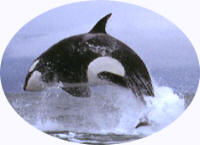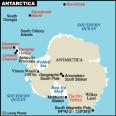Anarctica is an ice filled continent in
the north which hosts many animals.
Antarctica is so cold that no human can
live there although there are rumors that there were
eskimos living on the continent. Antartica hosts the north
pole along with predatory animals like the killer whale.
Obviously, having predatory animals,
it has prey on the continent aswell,
like seals. The Antarctic is currently in
danger of the ice caps melting,
meaning there will be no land and
the land animals would die.
This is due to global warming and the 'greenhouse affect'.
Below are some native animals to the
Antarctic.

Penguins are very native to the Antarctic. They are naturally adapted to the way they live. When an Antarctic explorer first found a penguin he thought it was a fish and so it was classified as a fish. Later on it was found out to be a bird. Penguins are completly flightless but as bird they are perfectly designed for the job. Flying underwater they can paddle up to 25 miles per hour. In the Antarctic penguins usually push themselves along on their stomach because their legs are so far out from their body that it is awkward for them to walk.They are very graceful and comical creatures in their own little ways. Out of the 17 species of penguin there are only four that breed on Antarctica; Adelie (pictured above), Emperor, Chinstrap and Gentoo.
Adelie
The Adelie penguin population is 2.5 million pairs. They are only about 30 inches tall and only wieght upto 11 pounds. They eat fish, krill and other small crustaceans and nests in circle mounds of small stones. It is the smallest penguin out of the 17 species and is also known as the 'little penguin'.
Emperor
The Emperor penguin, unlike the Adelie, is alot bigger and heavier than the rest. It can size upto 40 inches and weighs upto 44 pounds. Four times as heavy as the Adelie. There are only 200,000 pairs of emperor penguins in Antarctica. They feed on fish, squid and crustaceans and they don't nest.
Chistrap
Chinstrap penguins are the most popular on the island with a population of 7 million pairs. They are about 27 inches tall, feed on fish and krill and wieght about 9 pounds. They nest in high, snow-free ground. Amazing, they can dive upto 230 feet in half a minute.
Gentoo
Gentoo penguins are about 30 inches tall, wiegh 12 pounds and feed on crustaceans, krill and fish. They nest in circles of piled stones, pebbles, grass, or sticks and have a population of around 200,000 pairs.
Whales

There are many species of whale on the continent on Antartica because the icy cold waters are the perfect place fo whales to live. Whales are mammals, and so they breathe air. They have blowholes which they use to blow steams of water vapours. There are eight species of whale on the continent. These are the Blue Whale, Fin Whales, Minke Whales, Humpback Whales, Orca Whales, Southern Right Whales, Sei,and Sperm Whales
Blue whales
Biggest animal on world, and the loudest. Measures from 85 to 100 foot and is louder than a jet. 11,00 of them inhabit earth including Antarctic. Amazing, the biggest animals on earth only eats krill and other timy crustaceans! Blue Whales breathe through two blowholes, shooting water upto 50 feet high. Just one of these whales can eat 4.5 tons of krill in one day. Female whales have one calf every two or three years and reach sexual maturity at the age of 5 years. Gestation is usually 11 moths and calves are nursed for 7 to 8 months gaining usually 200 pounds a day.
Fin Whales
The second biggest of the whale bunch, these beautiful creatures can swim upto 20 miles per hour giving them the nickname 'greyhound of the sea'. These whales can spend upto half an hour underwater and can dive upto 800 metres deep when hunting for fish and squid. They are 80-90ft long and throughout the world there are 100,000 of them. They eat fish, krill and squid.
Humpback Whale
There are only 20,000 of these marvelous creatures left on earth spread across oceans worldwide. But still, on with the facts. Their flippers can grow upto a third of their body length which can be upto 16 feet on some of them. They are 40-50ft long and weigh upto 48 pounds. They eatly mainly on krill and fish. They eat their prey by circling schools of fish and when swallowing them up in a wida open mouth. The male whales are singers. They actually have songs they perform when deep under the surface of the ocean.
Minke Whale
Out of the rorqual or large baleen whales, this is the smallest. Norway and Japan still legally hunt these beautiful creatures. 500,000 minke whales live around the world and they eat krill, fish and squid. They grow upto 30 feet long and weigh upto 10 tons. Lika all whales the minke whales sing. The minke's song sounds very mechanical and caused problems in world war 2 when warships listened out for submarines.
Orca
This remarkable animal is called the orca whale, or as most people would know it as the killer whale. Several hundred thousand of these whales live around the world. They eat fish, marine animals and birds. They grow upto 25-30 feet long and weigh upto 7 tons. Like most whales, the orca calves come out tail first.
Southern Right
4000 of these whales live across southern oceans and they grow upto 50 feet long. They weigh upto 80 tons and eat plankton, krill and tiny crustaceans. Females have a gestation period of 7-10 months and give birth in the early sping. The right whales are called right whales because they are considered to be the 'right' whale to hunt.
Sei
Sei whales occupy oceans worldwide but there are only 70,000 of sei whales left. They grow upto 50 feet long and weigh upto 40 tons. They eat krill and other small crustaceans. They are the third largest in the southern ocean. They can swim upto 30 miles per hour in short bursts making it one of the fastest crustaceans in the sea.
Sperm
There are 750,000 sperm whales. They eat giant fish, fish, octupus and skate. They grow upto 50 feet long and weigh upto 40 tons. A sperm whale's head can be 20 feet long or a third of its body length. The sperm is the worlds deepest diving whale and can reach depths of upto one mile.
There are many more soon to come so check back.
Navigation
